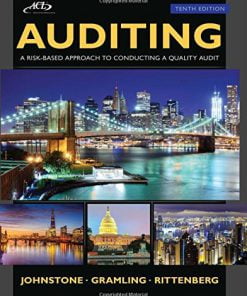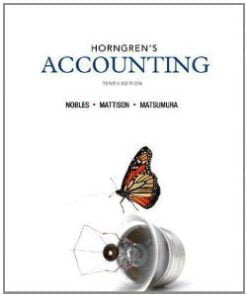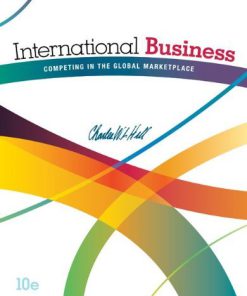Solution Manual for Global Marketing, 9/E – Warren J. Keegan & Mark C. Green
$35.00 Original price was: $35.00.$26.50Current price is: $26.50.
Solution Manual for Global Marketing, 9/E – Warren J. Keegan & Mark C. Green
Instant download Solution Manual for Global Marketing, 9/E – Warren J. Keegan & Mark C. Green pdf docx epub after payment.

Product details:
ISBN-13: 9780134138183
Author: Warren J. Keegan
- Dynamic Study Modules help students study effectively on their own by continuously assessing their activity and performance in real time. Here’s how it works: students complete a set of questions with a unique answer format that also asks them to indicate their confidence level. Questions repeat until the student can answer them all correctly and confidently. Once completed, Dynamic Study Modules explain the concept using materials from the text. These are available as graded assignments prior to class, and accessible on smartphones, tablets, and computers.
Table of contents:
1 Globalization Imperative 1
Why Global Marketing Is Imperative 4
Saturation of Domestic Markets 4
Emerging Markets 4
Global Competition 5
Global Cooperation 6
Internet Revolution 7
The Fluid Nature of Global Competition 8
Globalization of Markets: Convergence and Divergence 12
International Trade versus International Business 13
Who Manages International Trade? 17
Evolution of Global Marketing 19
What Is Marketing? 19
Domestic Marketing 20
Export Marketing 22
International Marketing 23
Multinational Marketing 24
Global Marketing 24
The Impact of Economic Geography and Climate on Global Marketing 26
Summary 28
Key Terms 28
Review Questions 28
Discussion Questions 28
Further Reading 29
Appendix: Theories of International Trade and the Multinational Enterprise 30
2 Economic Environment 38
Intertwined World Economy 40
Foreign Direct Investment 42
Portfolio Investment 44
Country Competitiveness 46
Changing Country Competitiveness 46
Human Resources and Technology 46
Emerging Markets 48
Evolution of Cooperative Global Trade Agreements 51
General Agreements on Tariffs and Trade 51
World Trade Organization 51
Information Technology and the Changing Nature of Competition 59
Value of Intellectual Property in Information Age 59
Proliferation of E- Commerce and Regulations 61
Regional Economic Arrangements 62
Free Trade Area 63
Customs Union 65
Common Market 66
Monetary Union 66
Political Union 67
Multinational Corporations 67
Summary 69
Key Terms 70
Review Questions 70
Discussion Questions 71
Further Reading 72
3 Financial Environment 73
Historical Role of the U.S. Dollar 74
Development of Today’s International Monetary System 75
The Bretton Woods Conference 75
The International Monetary Fund 76
The International Bank for Reconstruction and Development 77
Fixed versus Floating Exchange Rates 78
Currency Blocs 80
Foreign Exchange and Foreign Exchange Rates 81
Purchasing Power Parity 81
Forecasting Exchange Rate Fluctuation 83
Coping with Exchange Rate Fluctuations 83
Spot versus Forward Foreign Exchange 86
Exchange Rate Pass- Through 88
Cryptocurrencies: A New Development 88
Balance of Payments 89
The Internal and External Adjustments 93
Economic and Financial Turmoil around the World 94
Asian Financial Crisis (1997–1998) and Its Aftermath 94
The South American Financial Crisis (2001–2002) and Its Aftermath 95
The U.S. Subprime Mortgage Loan Crisis and the Subsequent Global Financial Crisis (2007–2009) 95
The COVID- 19 Pandemic (2020–Present) Causing the Worst Recession Since World War II 96
Economic and Financial Crises in Perspective 97
Responses to the Global Financial Crises 97
Marketing in the Euro Area 101
Historical Background 101
Ramifications of the Euro for Marketers 104
Summary 107
Key Terms 108
Review Questions 108
Discussion Questions 108
Further Reading 109
4 Global Cultural Environment and Buying Behavior 110
Meaning of Culture 112
Elements of Culture 113
Material Life 113
Language 114
Social Interactions 118
Aesthetics 119
Religion 121
Education 123
Value Systems 125
Cross- Cultural Comparisons 126
High- versus Low- Context Cultures 126
Hofstede’s Classification Scheme 127
World Value Survey (WVS) 131
Schwartz Value Survey (SVS) 131
Cultural Distance 134
Adapting to Cultures 135
Culture and the Marketing Mix 137
Product Policy 138
Pricing 140
Distribution 140
Promotion 141
Summary 144
Key Terms 145
Review Questions 145
Discussion Questions 145
Further Reading 147
5 Political and Legal Environment 148
Political Environment— Individual Governments 149
Home Country versus Host Country 149
Structure of Government 151
Government Policies and Regulations 154
Political Environment— Social Pressures and Political Risk 163
Social Pressures and Special Interests 164
Managing the Political Environment 166
Terrorism and the World Economy 171
International Agreements 174
Group of Seven (G7) Group of Eight (G8 now defunct) and Group of Twenty (G20) 176
Wassenaar Arrangement 177
International Law and Local Legal Environment 179
International Law 179
Local Legal Systems and Laws 179
Jurisdiction 183
Issues Transcending National Boundaries 184
ISO 9000 and 14000 184
Intellectual Property Protection 185
International Treaties for Intellectual Property Protection 191
Antitrust Laws of the United States 194
Antitrust Laws of the European Union 196
U.S. Foreign Corrupt Practices Act of 1977 197
Summary 200
Key Terms 200
Review Questions 201
Discussion Questions 201
Further Reading 203
6 Global Marketing Research 204
Research Problem Formulation 208
Secondary Global Marketing Research 210
Secondary Data Sources 210
Problems with Secondary Data Research 212
Primary Global Marketing Research 214
Focus Groups 214
Survey Methods for Cross- Cultural Marketing Research 215
Observational Research 222
Leveraging the Internet for Global Market Research Studies 222
Market Size Assessment 225
Method of Analogy 225
Trade Audit 228
Chain Ratio Method 228
Cross- Sectional Regression Analysis 229
New Market Information Technologies 230
Managing Global Marketing Research 232
Selecting a Research Agency 232
Coordination of Multicountry Research 233
Summary 234
Key Terms 235
Review Questions 236
Discussion Questions 236
Further Reading 237
7 Global Segmentation and Positioning 238
Reasons for International Market Segmentation 239
Country Screening 239
Global Marketing Research 240
Entry Decisions 240
Positioning Strategy 241
Resource Allocation 241
Marketing Mix Policy 243
International Market Segmentation Approaches 243
Segmentation Scenarios 244
Bases for International Market Segmentation 246
Demographics 247
Socioeconomic Variables 249
Behavior- Based Segmentation 251
Lifestyle and Values 252
International Positioning Strategies 254
Uniform versus Localized Positioning Strategies 257
Universal Positioning Appeals 259
Global Foreign and Local Consumer Culture Positioning 260
Summary 263
Key Terms 263
Review Questions 263
Discussion Questions 263
Further Reading 264
Appendix: Segmentation Tools 265
8 Global Marketing Strategies 269
Information Technology and Global Competition 270
Real- Time Management 270
Blockchain Technology 271
On- Time Communication 272
Electronic Commerce (E- Commerce) 272
E- Company 274
Faster Product Diffusion and Connectivity 274
Global Strategy 275
Global Industry 275
Competitive Industry Structure 279
Competitive Advantage 281
Hypercompetition 286
Interdependency 287
Global Marketing Strategy 288
Benefits of Global Marketing 289
Limits to Global Marketing 291
R&D Operations and Marketing Interfaces 293
R&D/Operations Interface 294
Operations/ Marketing Interface 296
Marketing/R&D Interface 298
Regionalization of Global Marketing Strategy 299
Cross- Subsidization of Markets 302
Identification of Weak Market Segments 302
Use of the “Lead Market” Concept 303
Marketing Strategies for Emerging Markets 304
Competitive Analysis 307
Summary 308
Key Terms 309
Review Questions 309
Discussion Questions 309
Further Reading 310
9 Global Market Entry Strategies 312
Country Selection 313
Scale of Entry 316
Choosing the Mode of Entry 317
Decision Criteria for Mode of Entry 317
Exporting 321
Indirect Exporting 322
Cooperative Exporting 323
Direct Exporting 323
Licensing 323
Benefits 324
Caveats 324
Franchising 325
Benefits 326
Caveats 326
Expanding through Joint Ventures and Alliances 327
Benefits 329
Caveats 329
Drivers behind Successful International Joint Ventures 330
Wholly Owned Subsidiaries 333
Benefits 333
Caveats 334
Acquisitions and Mergers 334
Greenfield Operations 338
Dynamics of Entry Strategies 338
Timing of Entry 340
Exit Strategies 342
Reasons for Exit 343
Risks of Exit 345
Guidelines 346
Summary 346
Key Terms 347
Review Questions 347
Discussion Questions 347
Further Reading 349
Appendix A: Country Screening— Converting Raw Data into a 10- Point Scale 349
Appendix B: Alternative Country Screening Procedure 350
Appendix C: Mode of Entry Choice— Three Theoretical Perspectives 351
10 Global Product Policy Decisions I: Developing New Products for Global Markets 353
Standardization versus Customization 355
Drivers toward Standardization 355
Modular Product Design Strategies 359
Multinational Diffusion 361
Developing New Products in the Global Marketplace 365
Identifying New Product Ideas 366
Screening 367
Concept Testing 368
Test Marketing 368
Timing of Entry: Waterfall versus Sprinkler Strategies 370
Truly Global Product Development 375
Summary 377
Key Terms 377
Review Questions 378
Discussion Questions 378
Further Reading 379
Appendix A: Using Conjoint Analysis for Concept Testing in Global New Product Development 380
Appendix B: Back- of- the- Envelope Calculations— Incremental Break- Even Analysis (IBEA) 382
11 Global Product Policy Decisions II: Marketing Products and Services 385
Global Branding Strategies 387
Global Branding 387
Local Branding 391
Brand Naming 393
Global or Local Branding? 395
Brand- Name Changeover Strategies 398
Management of Multinational Product Lines 401
Product Piracy 406
Strategic Options against Product Piracy 407
Country- of- Origin (COO) Effects 410
Country- of- Origin (COO) Influences on Consumers 411
Strategies to Cope with COO Stereotypes 413
Global Marketing of Services 416
Challenges in Marketing Services Internationally 416
Opportunities in the Global Service Industries 418
Global Service Marketing Strategies 419
Summary 420
Key Terms 421
Review Questions 421
Discussion Questions 421
Further Reading 422
12 Global Pricing 423
Drivers of Foreign Market Pricing 424
Company Goals 424
Company Costs 425
Customer Demand and Price Sensitivity 426
Competition 428
Distribution Channels 431
Government Policies 431
Managing Price Escalation 432
Pricing in Inflationary Environments 435
Global Pricing Currency Fluctuations and Tariffs 437
Currency Gain/Loss Pass Through 438
Currency Quotation 440
Tariff Pass Through 441
Transfer Pricing 441
Determinants of Transfer Prices 441
Setting Transfer Prices 443
Minimizing the Risk of Transfer Pricing Tax Audits 444
Global Pricing and Antidumping Regulation 445
Price Coordination 446
Global Pricing Contracts (GPCs) 447
Aligning Pan- Regional Prices 448
Implementing Price Coordination 450
Summary 450
Key Terms 451
Review Questions 451
Discussion Questions 451
Further Reading 452
13 Global Communication Strategies 453
Global Advertising and Culture 454
Language Barriers 454
Other Cultural Barriers 456
Communication and Cultural Values 457
Setting the Global Advertising Budget 458
Percentage of Sales Method 459
Competitive Parity 460
Objective- and- Task Method 460
Resource Allocation 460
Creative Strategy 461
The “Standardization” versus “Adaptation” Debate 461
Merits of Standardization 463
Barriers to Standardization 465
Approaches to Creating Advertising Copy 466
Global Media Decisions 468
Media Infrastructure 468
Media Limitations 469
Advertising Regulations 470
Choosing an Advertising Agency 474
Other Communication Platforms 476
Sales Promotions 476
Direct Marketing 477
Livestreaming 478
Global Sponsorships 479
Mobile (Brand- in- the- Hand) Marketing 481
Trade Shows 482
Product Placement 484
Branded Entertainment (Content) 485
Viral Marketing 485
Global Public Relations (PR) and Publicity 487
Globally Integrated Marketing Communications (GIMC) 488
Summary 490
Key Terms 490
Review Questions 490
Discussion Questions 491
Further Reading 491
14 Sales Management 493
Market Entry Options and Salesforce Strategy 495
Role of Foreign Governments 498
Cultural Considerations 499
Personal Selling 499
Cultural Generalization 500
Corporate (Organizational) Culture 501
Customer Relationship Management (CRM) 501
Myers–Briggs Type Indicator 502
Impact of Culture on Sales Management and Personal Selling Process 505
Salesforce Management 506
Salesforce Objectives 506
Salesforce Strategy 506
Recruitment and Selection 507
Training 508
Supervision 509
Evaluation 511
Cross- Cultural Negotiations 511
Cross- Cultural Intelligence 512
Stages of Negotiation Process 512
Cross- Cultural Negotiation Strategies 514
Expatriates 516
Advantages of Expatriates 517
Difficulties of Sending Expatriates Abroad 518
The Return of the Expatriate— Repatriation 521
Generalizations about When Using Expatriates Is Positive or Negative 522
Summary 523
Key Terms 523
Review Questions 523
Discussion Questions 524
Further Reading 524
15 Global Logistics and Distribution 526
Definition of Global Logistics 528
Managing Physical Distribution 530
Modes of Transportation 531
Warehousing and Inventory Management 534
Third- Party Logistics (3PL) Management 537
Logistical Revolution with the Internet 538
Managing Sourcing Strategy 540
Procurement: Types of Sourcing Strategy 541
Outsourcing of Service Activities 546
Free Trade Zones 550
International Distribution Channel 554
Channel Configurations 554
Channel Management 556
International Retailing 556
E- Commerce and Retailing 559
Private- Label Branding (Store Brands) 562
On- Time Retail Information Management 562
Retailing Differences across the World 564
Summary 567
Key Terms 568
Review Questions 568
Discussion Questions 569
Further Reading 570
People also search:
Global Marketing, 9/E pdf
Global Marketing
global market in moneycontrol
global marketing in a company
|
what does global marketing mean
|
Related products
Solution Manual
Solution Manual for Introduction to Robotics Mechanics and Control 3rd Edition by Craig
Solution Manual
Solution Manual
Solution Manual
Auditing A Risk Based-Approach to Conducting a Quality Audit Johnstone 10th Edition Solutions Manual
Solution Manual
International Business Competing in the Global Marketplace Hill 10th Edition Solutions Manual











